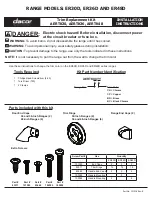
13
12
Adapting Liquid Amounts
When food is cooking in your
Kambrook Slow Cooker, most moisture
is retained. To allow for this when using
traditional recipes it is advisable to
halve the liquid content.
However, after cooking if the liquid
quantity is excessive, remove the
lid and operate the Kambrook Slow
Cooker on the HIGH Setting for 30-45
minutes or until the liquid reduces by
the desired amount. Alternatively, the
liquid can be thickened by adding a
mixture of cornflour and water.
Stirring the Food
Little or no stirring is required when
using the LOW setting. However,
stirring the food when using the
HIGH setting ensures better flavour
distribution and even cooking results.
Preparing Meat and Poultry
Select the leanest cuts when
purchasing meat. Trim the meat or
poultry of any visible fat. If possible,
purchase chicken portions without
the skin. Otherwise, the slow cooking
process will result in extra liquid being
formed from the fat as it melts.
For casserole-type recipes, cut the
meat into cubes, approximately
2.5cm to 3cm. Slow cooking allows
less tender cuts of meat to be used.
Suitable Meat Cuts for
Slow Cooking
Beef
Beef Chuck, Skirt, Round
Steak, Boneless Shin (Gravy)
Beef, Bone-In Shin (Osso
Bucco).
Lamb
Lamb Shanks, Neck Chops,
Best Neck Chops, Boned Out
Forequarter or Shoulder.
Veal
Diced Leg, Shoulder/
Forequarter Chops and
Steaks, Neck Chops, Knuckle
(Osso Bucco).
Pork
Leg Steaks, Diced Belly,
Diced Shoulder, Boneless Loin
Chops.
Chicken
Portions such as: drumsticks,
thigh meat, Maryland, Lovely
Legs, wing drummettes.
Browning Before
Slow Cooking
Pre-browning meat and poultry, prior
to slow cooking, seals in the moisture,
intensifies the flavour and provides
more tender results, whilst producing
richer flavours in other food, such as
onions, capsicums and leeks.
Pre-browning may take a little extra
time, and whilst not strictly necessary,
the rewards are evident in the end
results. Use a non-stick pan to reduce
the amount of oil required.
Roasting
Roasting meats in the Kambrook Slow
Cooker creates tender, flavoursome
results that are easy to slice. The long,
slow, covered cooking process breaks
down and softens the connective
and muscle tissue within the meat.
Cheaper cuts of meat can be used to
provide perfect results cooked by this
method.
Meat will not brown during the
roasting process, so for browner results
seal in a frypan before roasting.
The addition of liquid is not required
for roasting. Elevate the meat to
be roasted on heatproof trivet. This
will assist in keeping the surface of
the meat dry and free from any fat
released throughout the cooking
process.
Whole fresh chickens can be roasted
but if chickens that have been frozen
and thawed are used they may
release a significant amount of liquid
into the removable crockery bowl
whereby the chicken is pot-roasted or
steamed in this liquid.
Suitable Cuts for Roasting
Beef
Blade, Rump, Rib Roast,
Sirloin, Fresh Silverside,
Topside.
Lamb
Leg, Mid Loin, Rack, Crown
Roast, Shank, Shoulder, Mini
Roasts.
Veal
eg, Rack, Shoulder/
Forequarter.
Pork
Neck, Leg (remove skin
and fat), Racks.
Beginner’s Guide to Slow Cooking
continued
Pot Roasting
The addition of liquid is required for
pot roasting. Place sufficient liquid
into the removable crockery bowl to
cover up to a third of the meat. Meat
will not brown during the pot roasting
process. For browner results, seal in a
frypan before pot roasting.
Suitable Cuts for Pot Roasting
Beef
Beef Topside, Blade, Silverside
Roasts, Rolled Brisket.
Lamb
Forequarter, Shank, Shoulder.
Veal
Shoulder/Forequarter.
Pork
Loin, Neck.
Preparing Vegetables
Vegetables should be cut into
even-sized pieces to ensure more
even cooking. Frozen vegetables
must be thawed before adding
to other foods for cooking in the
Kambrook Slow Cooker.
Preparing Dried Beans
and Pulses
If time permits, overnight soaking of
dried beans and pulses is preferable.
After soaking, drain the beans or
pulses then place into the removable
crockery bowl and pour in water
that is double the volume of beans.
Ensure the removable crockery bowl
is at least ½ to ¾ full. Cook beans on
the HIGH setting for 2-4 hours or until
tender. Pre-soaked beans and pulses
will cook a little faster.
































